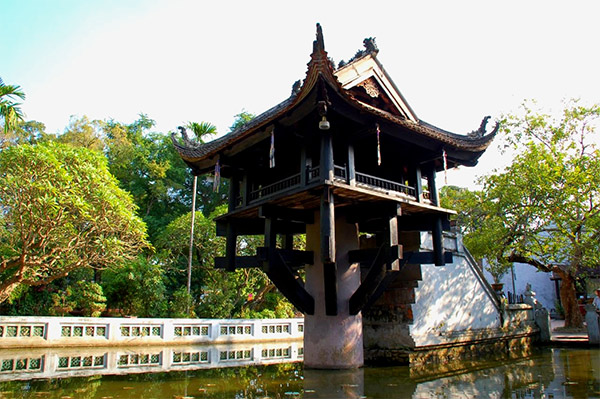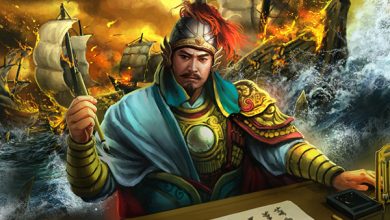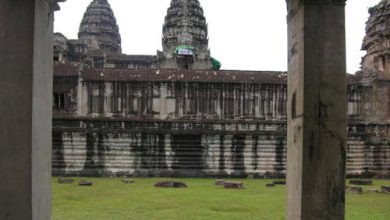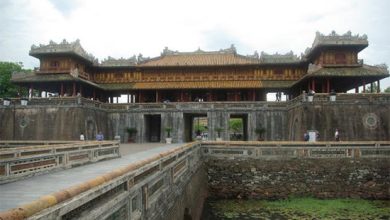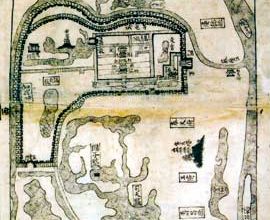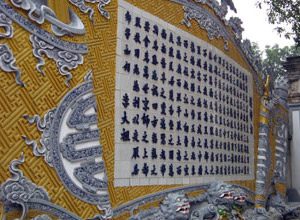One Pillar Pagoda
One Pillar Pagoda was built in 1049 in Dien Huu pagoda relics located by One Pillar Pagoda Street, near to Ho Chi Minh President Mausoleum, Ba Dinh District.
Legend has it that King Ly Thai Tong (1028 – 1054) was old but he had no son. One night, the King dreamed about Guan Yin Buddha sitting on a lotus, carying a boy and giving it to the king. Shortly after, the queen gave birth to a son. The king built a lotus-shaped pagoda and named it Dien Huu Pagoda.
The old pagoda was much larger than it is now; through the dynasties, One Pillar Pagoda was rebuilt several times; each restoration, the pagoda and the surrounding landscape was changed.
From the outset, when building Dien Huu pagoda, in front of the pagoda, they built a large stone columns on the ground; on the top of the column there was a statue of Guan Yin Buddha sitting on a lotus. This architecture refered to a type of Buddhist structure, often built to practise charity. This type of architecture started in vogue under Tang Dynasty, spread to Korea, Japan and Vietnam. Under Dinh – Le Dynasties, in our country this architecture was quite popular. Nam Viet Vuong Dinh Lien built 100 buildings of this architecture in 973.
Dien Huu – One Pillar Pagoda was a Buddhist architecture built in western garden of the Imperial Citadel. The garden was an ancient landscape architecture, built by kings and lords for recreation and rest.
The garden of the Imperial Citadel began to be built under Ly Dynasty in the west of the citadel which was located in Bach Thao Park and Ho Chi Minh museum today. Basing on the natural landscape of this place, they dug ponds and created artificial mountains, planted trees and released birds and animals, forming a large garden for the king, the royal family and mandarinsof Ly Dynasty.
One Pillar Pagoda has a unique architecture: a square wooden floor, put on a stone pillar in the middle of the pond. Around the stone pillar, there is a system of curved iron wood bars to support the floor; thus, the entire structure looks like a lotus upright from the water.
The current One Pillar Pagoda is only a part of Dien Huu Pagoda architectural complex, which was a Budhist architectural structure in front of the pagoda. Originally it was an octagonal stone pillar on the ground (the courtyard in front of the pagoda); the sides of the stone pillar were carved with Buddhist scriptures; the top of the pillar was a lotus and a statue of Guan Yin Buddha (without the worship fllor).
In 1106, it was restored and expanded by King Ly Nhan Tong to become a large architectural complex. The Budhist architectural structure in the front yard was added with new features. The structure was built in the centre of a square pond with lotuses called Linh Chieu Pond; on top of the pillar, there was a gilded lotus calyx. In the centre of the lotus calyx, there was a purple painted structure; the slopes and roof-top of which were incorporated with deity bird icons for decoration and expelling evils. A gilded statue of Buddha was placed in the structure. The lotus pond was surounded with painted corridors. The outside of the corriders was a moat; overbridges were built on each side to enter the pagoda. In the front yard, two towers roofed with glazed tiles were built at the two sides of the overbridge.
At the same time, along with the expansion of the pagoda, King Nhan Tong started solemn rites of “Buddha bathing” to pray for peace for the capital and the country on the first day of the month here, which later became monthly routine.
To the beginning of Tran Dynasty, in 1249, the pagoda was restored but remained the same architecture structure as in 1106.
To Mac Dynasty, perhaps the lotus calyx had already damaged, it was not mentioned in the documents. There was only “a stone pillar standing in the centre of the lotus pond with a precarious floor on the top; the four sides were surrounded with corridors”.
After King Le Trung Hung’s reign, along with the decline of the garden, the pagoda gradually deteriorated. According to records of Pham Dinh Ho, Dien Huu pagoda was roofed with bamboo thatch. The lotus pond of One Pillar Pagoda was abandoned with crumbling corridors. Only a bridge with curved roof in the front and the pillar remained with a small pagoda on the top, worshiping in the Bodhisattva Avalokiteshvara.
To 1805 under King Gia Long’s reign, Thang Long Citadel was renovated, the bridge was destroyed. The architectural vestiges of the One Pillar Pagoda under the Ly Dynasty almost dispeared.
About between 1840 – 1850, under the Nguyen Dynasty, One Pillar Pagoda was restored but it remains unknown how the restoration was. And in 1922, the pagoda was restored again.
On September 11, 1954, before the withdrawal from the capital, the French set mine to destroy the Pagoda, only the pillar with some wooden beams remained. After taking over Hanoi, the Government implemented the restoration of the pagoda as it is now.
One Pillar Pagoda under the Early Le, Mac Dynasties and after King Le Trung Hung’s reign was no longer as important as under the Ly-Tran Dynasties, but it was still respected.
Today, along with the Temple of Litterature, One Pillar Pagoda (restored in 1954), is commonly used as a symbol of thousand year culture Hanoi.
One Pillar Pagoda (Dien Huu or Lien Hoa Pagoda) is a special relic, a symbol of the capital, with the long history and cultural and spiritual values. But recently, this pagoda has degraded; water leaking from roofs to the statue, flooding worship houses as well as the road to the pagoda, etc.
It is expected that in 2012, the pagoda of nearly 1,000 years old located in the heart of the capital will be restored to avoid degradation and dilapidation. The restoration is planned to be completed by the 1st quarter of 2013.

